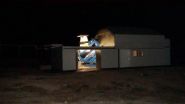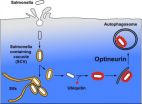(Press-News.org) A team of researchers from the Royal Institute and Observatory of the Navy (ROA) in Cádiz (Spain) has developed a method to track the movement of geostationary objects using the position of the stars, which could help to monitor space debris. The technique can be used with small telescopes and in places that are not very dark.
Objects or satellites in geostationary orbit (GEO) can always be found above the same point on the Equator, meaning that they appear immobile when observed from Earth. By night, the stars appear to move around them, a feature that scientists have taken advantage of for decades in order to work out the orbit of these objects, using images captured by telescopes, as long as these images contain stars to act as a reference point.
This method was abandoned when satellites started to incorporate transponders (devices that made it possible to locate them using the data from emitted and reflected signals). However, the classic astrometric techniques are now combing back into vogue due to the growing problem of space waste, which is partly made up of the remains of satellites engines without active transponders.
"Against this backdrop, we developed optical techniques to precisely observe and position GEO satellites using small and cheap telescopes, and which could be used in places that are not particularly dark, such as cities", Francisco Javier Montojo, a member of the ROA and lead author of a study published in the journal Advances in Space Research, tells SINC.
The method can be used for directly detecting and monitoring passive objects, such as the space junk in the geostationary ring, where nearly all communications satellites are located. At low orbits (up to around 10,000 km) these remains can be tracked by radar, but above this level the optical technique is more suitable.
Montojo explains that the technique could be of use for satellite monitoring agencies "to back up and calibrate their measurements, to check their manoeuvres, and even to improve the positioning of satellites or prevent them from colliding into other objects".
"The probability of collisions or interferences occurring between objects is no longer considered unappreciable since the first collision between two satellites on 10 February 2009 between America's Iridium33 and the Russians' Cosmos 2251", the researcher points out.
Image software and 'double channel'
The team has created software that can precisely locate the centre of the traces or lines that stars leave in images (due to photograph time exposure). The main advantage of the programme is that it "globally reduces" the positions of the object to be followed with respect to the available stellar catalogues. To do this, it simultaneously uses all the stars and all the photographs taken by the telescope's CCD camera on one night. It does not matter if there are not sufficient reference stars in some shots, because they are all examined together as a whole.
Optical observation allows the object to be located at each moment. Using these data and another piece of (commercial) software, it is possible to determine the orbit of the GEO object, in other words to establish its position and speed, as well as to predict its future positions. The method was validated by tracking three Hispasat satellites (H1C, H1D and Spainsat) and checking the results against those of the Hispasat monitoring agency.
"As an additional original application, we have processed our optical observations along with the distances obtained using another technique known as 'double channel' (signals the travel simultaneously between two clocks or oscillators to adjust the time)", says Montojo. The Time Section of the ROA uses this methodology to remotely compare patterns and adjust the legal Spanish time to International Atomic Time.
Incorporating these other distance measurements leads to a "tremendous reduction" in uncertainty about the satellite's position, markedly improving the ability to determine its orbit.
Data from the ROA's veteran telescope in San Fernando (Cádiz) were used to carry out this study, but in 2010 the institution unveiled another, more modern one at the Montsec Astronomical Observatory in Lleida, co-managed by the Royal Academy of Sciences and Arts of Barcelona. This is the Fabra-ROA Telescope at Montsec (TFRM), which makes remote, robotic observations.
"The new telescope has features that are particularly well suited to detecting space junk, and we hope that in the near future it will play an active part in international programmes to produce catalogues of these kinds of orbital objects", the researcher concludes.
INFORMATION:
References:
Montojo, F. J.; López Moratalla, T.; Abad, C. "Astrometric positioning and orbit determination of geostationary satellites". Advances in Space Research 47 (6): 1043-1053, 2011. DOI: 10.1016/j.asr.2010.11.025.
Stars help to track space junk
2011-05-29
ELSE PRESS RELEASES FROM THIS DATE:
Organizing Your Notes Just Got Easier with AlfaPad Notes Organizer 2011
2011-05-29
This neat and tidy software can help in organizing your thoughts as they day races by, eliminating the problem of finding the notes you know are somewhere on your hard drive. Save all that time spent looking for bank account numbers, PINs, addresses and phone numbers. Now it is cheap and easy to store all your notes, to-do lists, memos and business data in one organized place, so you can find them quickly when you need them. Along with logging your daily activities, so you can effectively track how you use your time.
AlfaPad Notes Organizer uses an intuitive, double-paned ...
Research shows a visit to a zoo boosts science and environment knowledge
2011-05-29
Research from the University of Warwick shows a trip to the zoo can boost your child's science and conservation education more than books or classroom teaching alone.
In research conducted at ZSL London Zoo, more than 3,000 school children aged between seven and 14 were asked about their knowledge of animals, habitat and conservation and then tested again after their trip.
The results show that 53% had a positive change in educational or conservation-related knowledge areas, personal concern for endangered species or new empowerment to participate in conservation ...
Attendance Tracking Software From Halfpricesoft.com Eases Employee Time Tracking Pressure For Small Businesses And HR Managers
2011-05-29
Halfpricesoft.com(www.halfpricesoft.com) released a new version of its employee attendance and time software, ezTimeSheet. This update is the software developer's response to customers' requests for increased reporting options.
ezTimeSheet software makes it easy and affordable to automate employee attendance management processes and slashes the time to run payroll for small businesses. This employee attendance and time tracking software was designed specifically for small business owners and HR department managers. And the newly released update version is more powerful ...
Intestinal cell defense mechanism against bacteria
2011-05-29
FRANKFURT. Salmonella is widely prevalent in the animal kingdom. The reason we do not suffer from severe intestinal infections very often is due to our body's defence system, which manages to digest invading bacteria. This is why, generally speaking, a healthy human being will only fall ill if he consumes more than 100.000 salmonella bacteria via a contaminated food source, such as eggs or meat. An international team of researchers, led by Prof. Ivan Dikic from the Goethe University in Frankfurt has now found out how body cells recognise salmonella and render it harmless. ...
Dr. David Sloss, Named Medical Director at Casa Grande Regional Medical Center
2011-05-29
Dr. Sloss received his Bachelor of Science in Biomedical Engineering at The Johns Hopkins University in Baltimore, Maryland. He earned his medical degree from the University of Colorado Health Sciences Center School of Medicine in Denver, Colorado. Dr. Sloss completed his residency at Washington University, Barnes-Jewish Hospital, in St. Louis, Missouri. He was a staff physician at the Emergency Department at SSM St. Joseph Hospital West in St. Louis, Missouri. Dr. Sloss has training in incident response to terrorist bombings and prevention and response to suicide bombing ...
When cancer runs in the family
2011-05-29
5% to 10% of all breast cancers are monogenic in origin. In other words, there is a mutation of the genes BRCA1, BRCA2 or other high-risk genes. In this edition of Deutsches Ärzteblatt International (Dtsch Arztebl Int 2011; 108(19): 323 30), Alfons Meindl of the Klinikum rechts der Isar (Munich) and coauthors report on new insights into the pathogenesis and treatment of hereditary breast and ovarian cancer and newly-discovered risk genes.
Meindl et al. evaluated data including those derived from the work of the German Consortium for Hereditary Breast and Ovarian Cancer. ...
Dogs in motion
2011-05-29
The reason being: "So far scientific studies were limited mostly to the movement of sick animals or to single aspects of locomotion", says Fischer, Professor of Systematic Zoology and Evolutionary Biology. To change this, Professor Fischer and his team started a comprehensive study about the locomotion of healthy dogs in 2006 and have now presented the results.
With enormous technical effort the scientists measured, documented and compared the motion sequences of 327 dogs from 32 different breeds. The dogs were filmed by two high speed cameras in different gaits from ...
Investec: Attractive Closed End Funds Discounts Gives Rise To Latest Lending Proposition.
2011-05-29
Investec offers specialised lending for deals in the closed-end funds market
- Investec believes many closed-end funds are trading at attractive discounts to their net asset values (NAVs)
- Consolidation is expected in the closed-end fund space
- Investec's lending is expected to be concentrated around funds focusing on alternative asset classes
Investec Specialist Private Bank ('Investec') has launched a new lending proposition for fund managers looking for 'event driven financing' focused on the closed-end fund space. This includes financing mergers; the acquisition ...
Christian Brothers Automotive Corporation Honored with 2011 Houston Better Business Bureau Award
2011-05-29
Christian Brothers Automotive Corporation, a national automotive repair chain known for its upscale home-charm decor and ethical business practices, has been honored with the Houston Better Business Bureau's (BBB) coveted Excellence Winner of Distinction award. This marks the sixth time, and second-consecutive year, the corporate office has been recognized with this award.
The BBB Excellence Winner of Distinction award recognizes companies that demonstrate a consistent commitment to ethics, overall excellence and quality in the workplace.
"Christian Brothers ...
What fish is on your plate?
2011-05-29
Low-cost catfish fillets sold as expensive sole fillets or cod caught in the North Sea but declared as originating from the Baltic Sea are both examples of types of fraud in the fisheries sector. A European Commission report published today shows how molecular technologies - based on genetics, genomics, chemistry and forensics - can provide clear answers to questions such as "what species does this fish product come from….where was this fish caught….is it wild or farmed?". The report by the Commission's Joint Research Centre (JRC), is called "Deterring illegal activities ...


